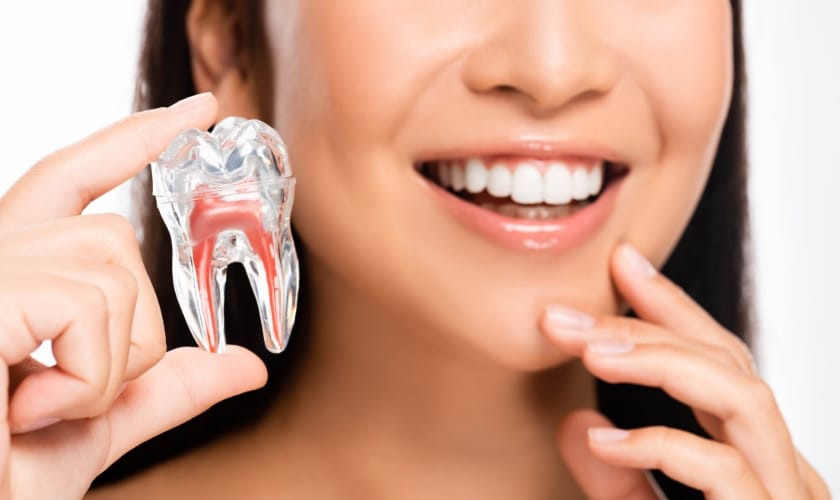Pay Online
What Are the 4 Symptoms of Tooth Decay?

Tooth decay is a serious dental condition that can affect people of all ages. It can begin as small wear on the enamel but can rapidly progress to discomfort, pain, or even infection. If you do not take the decay seriously, you can even lose a tooth. The sooner you recognize the symptoms of tooth decay, the more likely you are to avoid any complications.
In this blog, we will discuss four important signs of tooth decay that you must never overlook. If you see any of these warning signs, it is important to visit a professional at the earliest to save your oral health.
1. Tooth Sensitivity: A Warning Sign from Your Enamel
Did you ever experience an acute stinging pain in your teeth while taking a sip of hot coffee or biting into a scoop of ice cream? That painful feeling might be an indicator of tooth decay.
Why Sensitivity Happens?
- Enamel covers the inner layers of your teeth.
- Once decay begins, it wears down the enamel, exposing the dentin (the softer layer below).
- Dentin contains small tubes that lead to the nerves within your tooth, so it is more sensitive to heat and some foods.
Typical Causes of Tooth Sensitivity:
- Hot or cold beverages and foods
- Sweet or sour foods
- Brushing or flossing close to the sensitive tooth
If sensitivity persists or gets worse over time, it may be a sign that decay is progressing. Disregarding this symptom can result in deeper cavities and more pain.
2. Tooth Pain or Discomfort: When Decay Reaches Deeper Layers
Toothache is usually the most apparent sign of decay, but it does not necessarily begin as a sharp, excruciating pain. In most instances, the pain starts as a mild ache and slowly gets worse.
Types of Tooth Pain Associated with Decay:
- Mild, intermittent discomfort: You might experience sensitivity when chewing or consuming something cold.
- Dull, persistent ache: A persistent toothache may signal that decay has penetrated the dentin layer.
- Acute, severe pain: This might indicate that the decay has spread to the pulp (the very center of the tooth that contains nerves).
Pain can also be spontaneous, appearing without any apparent cause. If you experience discomfort when chewing or applying pressure to a particular tooth, decay might be compromising the tooth’s structure.
3. Visible Holes or Dark Spots: Signs of Cavity Formation
One of the easiest signs of tooth decay is small holes, pits, or dark spots on your teeth. Though some cavities develop in deep crevices between teeth, others are obvious on chewing surfaces or along the gum line.
What Do Cavities Look Like?
- Pinhead-sized holes or indentations
- Brown, black, or white spots on the enamel
- Rough or uneven tooth surfaces
First, the enamel starts to weaken, and ultimately, cavities form. When you do not treat this situation, the holes expand, and bacteria get deeper into your mouth. Routine checkups with a general dentist in Elgin will help to detect cavities in their initial stages.
4. Bad Breath and Unpleasant Taste: A Hidden Symptom of Decay
Chronic bad breath (halitosis) is frequently related to poor oral health, but in some cases, it may be due to tooth decay. As tooth decay advances, bacteria collect within the affected area and release unpleasant odors.
Why Do Decayed Teeth Cause Bad Breath?
- Bacteria break down food particles lodged within cavities and release bad smells.
- Decaying teeth form areas where plaque and debris collect.
- Infections within the gums or tooth may lead to a bad taste in the mouth that is persistent.
If brushing, flossing, and mouthwash don’t improve your breath, it’s worth having a check for underlying decay.
Most of the time, tooth decay begins with mild symptoms such as sensitivity and light pain before becoming full-blown problems. If you notice any of these danger signs, take steps immediately. Contact your dentist and get the necessary help.
Recent Posts

Swelling, Fever, or Abscess? How to Spot a Dental Emergency Early

Unlock Your Annual Maximum: The Hidden Financial Benefit of Your Dental Insurance’s “Use-It-or-Lose-It” Policy

Bad Breath in Children: Common Causes and Solutions from a Dentist in Elgin

Northeast Family Dental Care Elgin Explains Best Habits to Prevent Tooth Grinding


